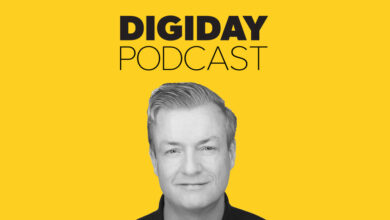With ‘Charlie,’ Pfizer is building a new generative AI platform for pharma marketing

Pfizer has developed its own generative AI platform and named it after the pharmaceutical giant’s founder.
Since last year, Pfizer has been developing a new AI platform to help with content supply chains and while also overhauling the company’s entire marketing workbench. “Charlie,” named after Pfizer co-founder Charles Pfizer, is now in the process of rolling out to the entire organization. Executives say it’s still early, but the platform is now in use by Pfizer’s hundreds of people in central marketing team and thousands across the company’s various brands. It’s also being used by agency partners including Publicis Groupe and IPG.
A key focus for Charlie is improving the company’s content supply chain, according to Bill Worple, Pfizer’s vp of customer engagement platforms and technology. Along with helping with content creation and editing, Charlie also helps with fact-checking and legal reviews — something that’s especially important with highly regulated industries like pharma. Using a “red, yellow, green” risk system when labeling content, Charlie can identify assets the medical review team might want to spend more time looking over. For example, a headline used many times might not need as much attention. Other creative assets might use previously approved language but now appear in a new setting while other content making new claims deserves the most time.
“The whole idea there is how do we triple [or] 5x our content creation to actually create messaging that resonates both for the health care providers as well as our patients,” Worple said.
Another focus is turning Charlie into a workbench for the entire marketing organization. That includes integrating media analytics for the company’s brands, insights about various competitors and data from various websites. Charlie is also being integrated into Adobe platforms like Workfront and Experience Manager to help users take actions based on insights across various dashboards. Other features include integrating platforms like Slack so employees can communicate and share info with each other.
As for the type of content Charlie helps create, Pfizer is starting with digital media, emails and digital presentations that sales teams use with physicians. Another area it’s exploring is helping to research and write drafts for medical articles. Charlie also is able to gather insights across therapeutic areas to better understand customers and treatments. For example, Worple mentioned how a parent might be affected by a migraine differently than someone without a family.
“You actually start creating different insights into who your customer is,” said Worple. “And then [knowing] what the actual pain point is for them. It’s not something we would classify as medical research. That insight of ‘X percentage of these people are this type of individual’ really helps you understand who your customer is. Now you know how to talk to them better.”
Spinning off Marcel
Charlie was trained on data from a range of sources, according to Worple. For generating marketing content, Pfizer uses training data from approved content that is filed by each category of treatment (such as oncology, endocrinology, etc.) and by specific products. It also uses segmentation models to teach Charlie about types of messaging that’s relevant to each segment and what’s most important.
While content creation is powered by a custom version of ChatGPT, Charlie uses recommendation algorithms. Pfizer’s also creating ways to use natural language processing (NLP) for queries related to internal research, cases studies and performance marketing data. And to prevent Charlie from giving inaccurate information or other “hallucinations,” answers are validated with source material based on previously published and validated Pfizer content. There’s also a process for reviewing and validating outputs.
Pfizer’s efforts are a collaboration with Publicis Groupe, which helped to build Charlie based on its existing Marcel AI platform. According to Marcel president Arpit Jain, Marcel is like the “base house” and Charlie is the version customized to Pfizer’s needs. He added that Publicis Groupe also has a dedicated team that helps maintain and evolve Charlie every day. Last month, Publicis announced major AI updates of its own including a new platform called CoreAI.
Because health care data is so sensitive, Pfizer is making sure Charlie’s collection and use of data meets various internal and external privacy requirements. Based on who is using Charlie, the platform can tailor its features to an employee’s role, how they use it and the types of data users engage with. That all makes data governance especially key, both in terms of accuracy and privacy.
“You’ve got to be very careful,” Jain said. “The last thing you want is to have some crazy data that you did not clean up right. And especially in healthcare, it could be a matter of life and death. If you recommend the wrong iPhone, it’s OK — it’s not the end of the world. But if you recommend the wrong medicine, God forbid something like that happens.”
Along with content creation, using generative AI for medical, legal and regulatory reviews is a key feature other pharma companies are also exploring, according to analysts covering the space. It’s also seen as low cost and lower risk, but high reward.
Marketers are excited about using generative AI to help with global rollouts of content that’s translated AI and localized for each market, according to Gartner analyst Chris Beland.
“The cost optimization potential is significant, but not without risk,” Beland said. “There are obvious implications in a consumer or [health care providers] seeing flawed or unauthentic content, but there could also be unintentional implications on the strategic, measurement, and approval workflows if not properly planned for.”
Generating ads — and more
Beyond marketing, generative AI could generate between $60 billion and $110 billion in annual economic value for the pharma and medical product industries, according to a January report by the McKinsey Global Institute. The report also mentioned that marketing-related uses for generative AI could help halve content creation costs and increase production pipelines by 20%. The technology could also double or triple the speed of approving content.
According to WARC, pharma and healthcare companies make up the third-fastest growing product segment for global ad spending behind financial services and technology/electronics. In the U.S. alone, the firm forecasts pharma and healthcare ad spending to reach $34.6 billion in 2024, or 16.7% more than 2023.
Some companies in various industries are exploring ways to generate synthetic data based on first-party data, according to Paul Stringer, WARC’s managing editor for research & insights. That way, companies can create audiences to look like their customers without exposing any personal information. However, he said it’s important that companies make sure they don’t end up replicating real-world biases in the process.
“If you don’t give these generative AI models the right training data, what you end up doing is leaving yourself at massive, massive risk of amplifying the existing bias and gaps in your customer data,” Stringer said.
Other agencies are also building their own generative AI tools for pharma clients. One is CMI Media Group, a media agency owned by WPP. (A few weeks ago, WPP said it would invest £250 million in 2024 to build its AI initiatives.) According to Justin Freid, CMI’s chief media & innovation officer, the tool will debut later this month and already is being tested with social and display ads, with a plan to later include video.
Along with helping in legal reviews, CMI is using the tool to help generate content personalized for each audience or optimized based on a platform’s performance data. For example, it might include changing the background of an ad based on the season of the year. The variations all still stay within set creative guidelines, but Freid said it opens up “a myriad of testing opportunities” to see what works with each audience.
“They still do need to be approved, but these are variations of creative versus like whole new campaigns,” Freid said. “The in-depth analysis of that new ad doesn’t need to be done…It’s nothing ridiculous where it’s a new tagline with a new claim or anything like that. We keep it simple, but we have found it to be more effective if it is more relevant to the end user.”



